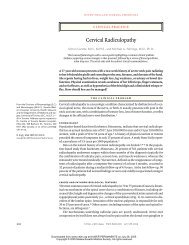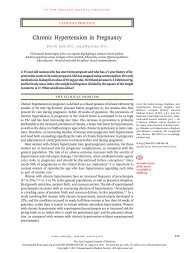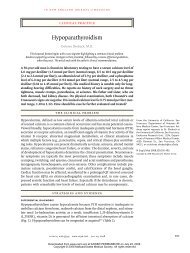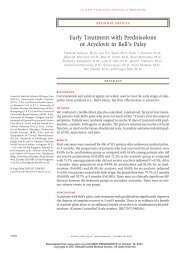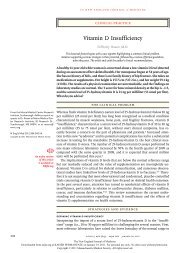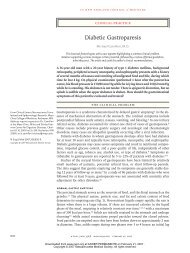Thrombotic thrombocytopenic purpura - Cleveland Clinic Journal of ...
Thrombotic thrombocytopenic purpura - Cleveland Clinic Journal of ...
Thrombotic thrombocytopenic purpura - Cleveland Clinic Journal of ...
Create successful ePaper yourself
Turn your PDF publications into a flip-book with our unique Google optimized e-Paper software.
THROMBOTIC THROMBOCYTOPENIC PURPURACROWTHER AND GEORGEDevastatingcompromiseand neurologicdeficits arecompletelyreversible inmost caseswas not previously noted by the patient or herfamily. Her laboratory findings:• White blood cell count 16.7 × 10 9 /L (referencerange 4.5–11.0)• Platelet count 32 × 10 9 /L (150–350)• Hemoglobin concentration 6.5 g/dL(1.4–17.5)• Peripheral blood smear: normal whitecells, rare platelets, red cells normochromicwith many fragments• Lactate dehydrogenase (LDH) concentration2,300 U/L (100–200).In view <strong>of</strong> her symptoms and laboratoryvalues, the physician suspects she may haveTTP and refers her to McMaster UniversityMedical Center in Hamilton, Ontario,Canada. Plasma exchange is started immediately;one plasma volume is removed andreplaced with fresh frozen plasma.Nevertheless, the patient’s condition deterioratesovernight, she becomes more confusedand cannot protect her airway, her LDH concentrationrises further, and her hemoglobinconcentration falls. She is transferred to theintensive care unit. Her plasma exchange prescriptionis increased to 1.5 volumes twicedaily (although little evidence exists that plasmaexchange twice daily is more effectivethan once daily).On the third day <strong>of</strong> her stay, she becomescompletely paralyzed on the left side. In additionto her twice-daily plasma exchange procedures,a plasma infusion and corticosteroidtherapy are initiated. Her platelet count stabilizesat about 20 × 10 9 /L.The patient next develops renal insufficiencyand requires three acute hemodialysistreatments. (Plasma infusion frequently leadsto volume overload in critically ill patients.Some intravascular volume can be removedwith plasma exchange; however, significantvolume overload with significant renal insufficiencycan only be treated with renal replacementtherapy.)The patient undergoes 28 consecutivedays <strong>of</strong> twice-daily plasma exchange and graduallyimproves, as measured by increasingplatelet counts, a gradual fall in the LDH concentration,and stabilization <strong>of</strong>—and ultimatelyan increase in—the hemoglobin level.She is weaned <strong>of</strong>f plasma infusions, and thenplasma exchange is tapered to once a day andthen to alternate days.She is completely well at the time <strong>of</strong> discharge4 weeks after her initial admission,with no residual deficits.Comment. This case shows that evenpatients with apparently devastating compromiseand neurologic deficits can completelyrecover with aggressive plasma exchange andother therapies. One child treated at theHospital for Sick Children, affiliated with theUniversity <strong>of</strong> Toronto, developed TTP andhad 120 consecutive days <strong>of</strong> plasma exchange:she was unconscious and comatose for much<strong>of</strong> that time, but she ultimately recovered andis now completely well without residual neurologicdeficits.■ TTP MAY BE DUETO ADAMTS13 DEFICIENCYTwenty-five years ago, little was known aboutTTP except for its clinical manifestations.Now, it is known to be caused in some patientsby an acquired deficiency <strong>of</strong> a circulating metalloproteinase.In very rare cases a hereditarydeficiency <strong>of</strong> ADAMTS13 causes TTP. Inaddition, a number <strong>of</strong> conditions share clinicalfeatures with TTP but have other underlyingcauses.In acquired TTP, an autoantibody formsagainst ADAMTS13, a zinc-containing metalloproteinasethat is also known as vonWillebrand factor-cleaving protease. Normally,von Willebrand factor circulates inplasma as multimers that allow platelets toadhere to vascular surfaces. When vonWillebrand factor is initially released fromendothelial cells, it exists as large multimers,which are more adhesive for platelets thannormal. These large multimers are normallycleaved into smaller units by ADAMTS13. IfADAMTS13 is lacking, the very-high-molecular-weightvon Willebrand factor multimersaccumulate, causing platelet agglutinationand the vascular occlusion that results in themanifestations <strong>of</strong> TTP.In 1994, ADAMTS13, the gene <strong>of</strong> whichis on the ninth chromosome, was shown tocleave von Willebrand factor under conditions<strong>of</strong> high shear stress. In 1996, a congenitalhomozygous deficiency <strong>of</strong> ADAMTS13was found to be associated with platelet370 CLEVELAND CLINIC JOURNAL OF MEDICINE VOLUME 75 • NUMBER 5 MAY 2008
esults cause confusion: a patient can have anormal level <strong>of</strong> ADAMTS13 and still haveTTP that responds to plasma exchange, andlevels can be low in conditions other thanTTP.■ THE CHALLENGES OF TREATMENTPlasma exchangeis the primary treatment for TTPRock et al 2 performed a randomized trial inwhich 102 patients with TTP received eithera 1.5-volume plasma exchange daily for 3 daysand then 1-volume plasma exchanges as neededto control the disease or plasma infusion.Patients who received plasma exchange had abetter initial response, a higher survival rate,and a lower rate <strong>of</strong> relapse than patientsreceiving plasma infusion. These findingsestablished plasma exchange as the treatment<strong>of</strong> choice for TTP.However, the trial had some inherentproblems: patients who had plasma infusionstended to develop renal insufficiency and as aresult did not receive as much plasma becausethey could not tolerate as much volume asthose who had plasma exchange. Plasmaexchange probably worked better because itcould deliver more plasma over a fixed period<strong>of</strong> time, enabling patients to obtain more <strong>of</strong> theADAMTS13 enzyme, rather than because itwas an intrinsically better treatment. Thisinterpretation is the basis for our occasional use<strong>of</strong> twice-daily plasma exchange in critically illpatients.TTP is different from other autoimmunediseases such as idiopathic thrombocytopenia<strong>purpura</strong>, in which the primary treatments areimmunosuppressive agents. Some evidenceexists for treating TTP with immunosuppressiveagents, but the primary treatment shouldbe plasma exchange.Plasma infusion is useful in some casesAlthough small case series and our own experienceprovide evidence for the benefit <strong>of</strong>treating TTP with high-dose plasma infusions(25 mL/kg/day, or about 1.5 to 2.0 L/day for anaverage-sized adult), problems will likely arisewith volume overload if the patient has anysignificant renal insufficiency. Dialysis orultrafiltration may be used to treat volumeoverload; however, it is difficult to remove thelarge volumes <strong>of</strong> fluid required for high-volumeplasma infusion.Plasma infusion should be reserved fortwo situations:• If plasma exchange cannot be promptlystarted• For patients with very severe or refractorydisease, between plasma exchange sessions.Benefit <strong>of</strong> cryoprecipitate-poorplasma is uncertainFresh frozen plasma is believed to containnearly physiologic levels <strong>of</strong> all <strong>of</strong> the plasmaproteins. When plasma is cooled to around4˚C, a precipitate forms that contains a variety<strong>of</strong> substances, including the higher molecularweight multimers <strong>of</strong> von Willebrand factor.Because TTP involves excess large multimers,giving plasma in which the high molecularweight multimers have been removedshould in theory be better. In many centers,such cryoprecipitate-poor plasma is routinelyused to treat TTP.However, evidence that cryoprecipitatepoorplasma is better is lacking. A largestudy in Canada evaluating this questionwas terminated because <strong>of</strong> a lack <strong>of</strong> patientaccrual, a common fate <strong>of</strong> clinical trials <strong>of</strong>rare diseases. A randomized study in 17patients failed to show an advantage <strong>of</strong> cryoprecipitate-poorplasma over regular plasma,but the study was too small to draw firm conclusionsgiven large confidence intervalsabout the point estimate <strong>of</strong> the treatmenteffect.Cryoprecipitate-poor plasma is moreexpensive than regular plasma and is not asavailable. We do not routinely use it in ourcenter to initially manage patients with TTP,but we do use it for patients who are refractoryto standard treatment.Scott et al 3 measured the concentration<strong>of</strong> ADAMTS13 in a variety <strong>of</strong> plasma productsand found that there are significantamounts in cryoprecipitate. Although givingcryoprecipitate-poor plasma provides less <strong>of</strong>the high molecular weight multimers, whichis desirable for patients with TTP, it also providesless ADAMTS13, which is not desirable.High-doseplasmainfusions <strong>of</strong>tencause volumeoverload inpatients withrenalinsufficiencyCLEVELAND CLINIC JOURNAL OF MEDICINE VOLUME 75 • NUMBER 5 MAY 2008 373
In general, if the diagnosis is uncertain,the safest course is to treat the patient withplasma exchange, then try to establish thediagnosis, because TTP is fatal if not promptlytreated. Although plasma exchange is probablyoverused, it is more innocuous thanuntreated TTP.■■ REFERENCES1. Ruutu T, Barosi G, Benjamin RJ, et al; European Group forBlood and Marrow Transplantation; EuropeanLeukemiaNet. Diagnostic criteria for hematopoietic stemcell transplant-associated microangiopathy: results <strong>of</strong> aconsensus process by an International Working Group.Haematologica 2007; 92:95–100.2. Rock GA, Shumak KH, Buskard NA, et al. Comparison <strong>of</strong>plasma exchange with plasma infusion in the treatment<strong>of</strong> thrombotic <strong>thrombocytopenic</strong> <strong>purpura</strong>. CanadianApheresis Study Group. N Engl J Med 1991; 325:393–397.3. Scott EA, Puca KE, Pietz BC, Duchateau BK, Friedman KD.Comparison and stability <strong>of</strong> ADAMTS13 activity in therapeuticplasma products. Transfusion 2007; 47:120–125.4. Bobbio-Pallavicini E, Gugliotta L, Centurioni R, et al.Antiplatelet agents in thrombotic <strong>thrombocytopenic</strong> <strong>purpura</strong>(TTP). Results <strong>of</strong> a randomized multicenter trial bythe Italian Cooperative Group for TTP. Haematologica1997; 82:429–435.5. George JN, Woodson RD, Kiss JE, Kojouri K, Vesely SK.Rituximab therapy for thrombotic <strong>thrombocytopenic</strong> <strong>purpura</strong>:a proposed study <strong>of</strong> the TransfusionMedicine/Hemostasis <strong>Clinic</strong>al Trials Network with a systematicreview <strong>of</strong> rituximab therapy for immune-mediateddisorders. J Clin Apher 2006; 21:49–56.ADDRESS: Mark A. Crowther, MD, Division <strong>of</strong> Hematology,McMaster University, St. Joseph’s Hospital, 50 Charlton AvenueEast, Hamilton, Ontario L8N 4A, Canada; e-mailcrowther@mcmaster.ca.Visit our web site athttp://www.ccjm.orgContact us by e-mail atccjm@ccf.orgCLEVELAND CLINIC JOURNAL OF MEDICINE VOLUME 75 • NUMBER 5 MAY 2008 375





